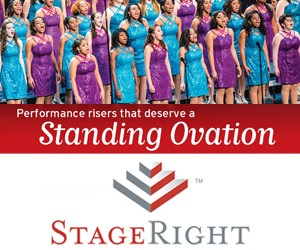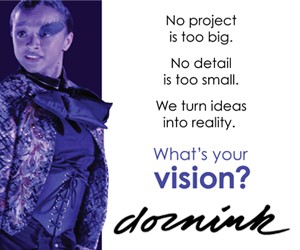
Others say it was said by understudies to the actors as they went on stage in hopes they would get their big chance at the lead parts. Even others attribute it to the bending of the leg to bow or curtsy in curtain calls thereby wishing them a performance that prompts numerous curtain calls.
Whatever the origin, the reality is that a broken leg or any other performance mishap for that matter is not a good thing. In another article on our blog, we talk about safety for your staging and risers.
Here, we’re going to talk about setting up trussing, wiring, lighting, costumes, props, and special effects in a way that keeps your performers safe.
Trussing
Trusses erected for lighting, microphones, or scenery must be properly secured with recommended anchoring devices like guide wires.
Add equipment to the rigging from the outside in while factoring in proper weight distribution.
All equipment mounted on the trusses must have safety wire retention in the event of loosening. Know your equipment weight, truss, and anchor capacities before you hang anything.
Wiring
Lighting, monitors, microphones and other electrical equipment should have cables secured to the floor with gaff tape eliminating potential trip hazards. Duct tape leaves a sticky residue and is not recommended. This helps prevent trip hazards on the stage.
Lighting
Strobes and other dynamic lighting effects can dramatically add to the performance; however, it can distract and visually impair a performer which creates a hazard for missteps or falls. Consider these possibilities while setting & adjusting lighting equipment.
Also, make sure that your stage wings have sufficient lighting for performers when they’re entering and exiting the stage.
Costumes
Costumes are sometimes of a style that performers aren’t normally comfortable in, particularly long flowing gowns and high heeled shoes. Multiple dress rehearsals help the performers feel at ease wearing expensive and often fragile costumes.
When designing or choosing costumes, examine for possible trip hazards. Costumes should be inspected prior to every performance for loose hems, seams, or trim.
Big brimmed floppy hats cause possible vision obstruction. When a dancer is worried about a head piece falling, concentration about where their feet are supposed to be can be distracted.
Props
As with costumes, the choirs need rehearsals with props until they’re comfortable using them. Canes, parasols, and other props can trip up performers, whether they’re amateurs or professionals.
You should use the regular prop in rehearsals that you are using in the performance until they feel familiar. You should never introduce any new elements without previous practice.
Special Effects
Fog, bubble machines, confetti, and other special effects are often used with Show Choir performances. As with lighting, special effects can be very dramatic but also pose a safety hazard.
Excessive moisture on the stage introduces slip hazards. Condensate collection pans under special effects generators will greatly reduce stage moisture and slippery surfaces.
If you are considering using pyrotechnics, make sure you understand your Fire Code regulations.
Always have a professional install and manage that element to ensure that no incidents occur.
Conclusion
When setting up for your next event, make sure you take the time to pay careful attention to every aspect of your performance, not just the stages and risers.
Lighting, costumes, props, and special effects can make your production even better; just make sure you use them properly.
Now, applying the preceding recommendations, proceed with peace of mind and continue the old traditions when saying, “Break a leg!”
See additional articles at https://performance.stageright.com/blog











